Mac OSX Tunnelblick / OpenVPN Setup
1. Start Configuration
Click Here to open a new window to login and configure the OpenVPN connection. Our system will automatically email your Config file to you or you also have the option to download it manually.

2. Choose a Server
If your account is on the Shared IP platform, you are welcome to choose any or as many servers as you like. If you have a Dedicated IP account your server details will be automatically selected for you.
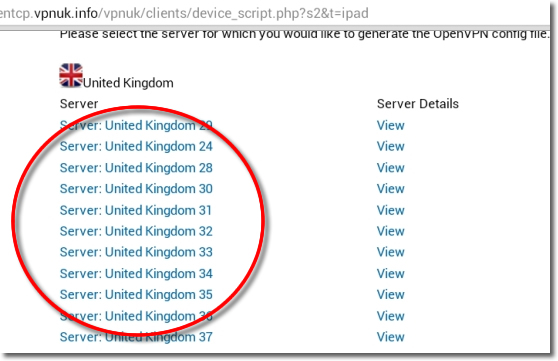
3. Get the config files
Click onto the download option, you have the option to download the files as UDP or TCP. If you prefer to have the files sent to your inbox, confirm your email address then click onto the ‘Continue’ button, this will instruct our server to email your config file to you. The email will arrive after a couple of minutes.

4. Download Tunnelblick
You can download the latest stable release for OS X from the Tunnelblick project page here: https://tunnelblick.net/downloads.html or from the VPNUK Downloads Area
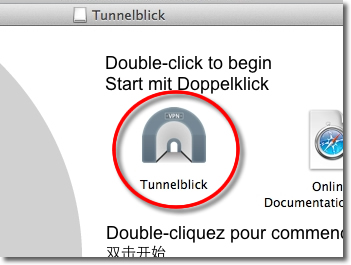
5. Confirm install
Click the ‘Install’ button to copy Tunnelblick to your hard drive.
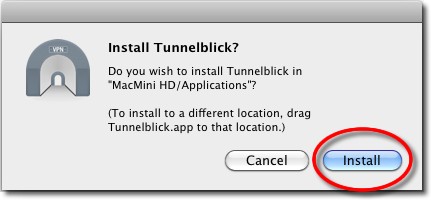
6. Installation complete
Once installation has completed a new window will appear, click the ‘Launch’ button.
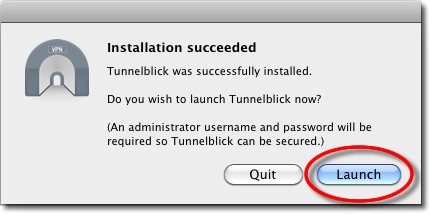
7. Tunnelblick Configurations
Tunnelblick will now ask you if you have a configuration file, select the button that reads ‘I have configuration files’.
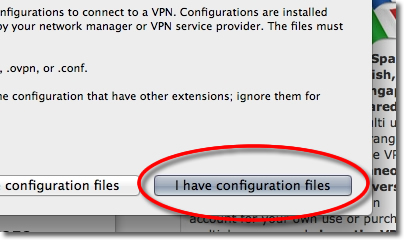
8. Add a Configuration
We now need to import the configuration from earlier. Click onto the ‘OK’ button.
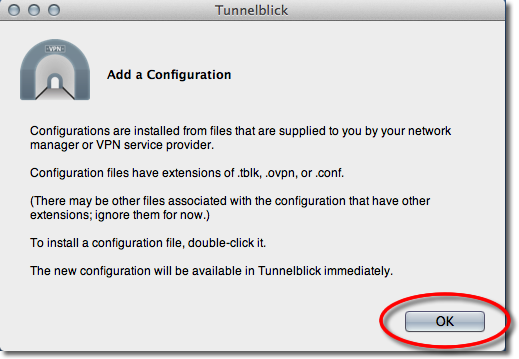
9. Open email client / go to Download location
Go to the OpenVPN configuration file that you downloaded or had emailed to yourself earlier, right click onto the file and choose ‘Open With’ – ‘Tunnelblick’

10. Install Configuration
Confirm the installation of the file for ‘All Users’, you can also select ‘Only Me’.
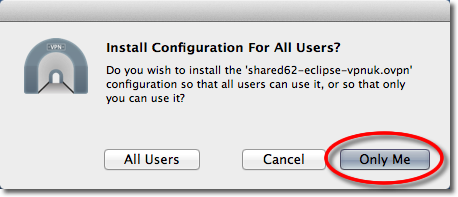
11. Connect to VPNUK through Tunnelblick
Click onto the Tunnelblick icon and select ‘Connect’. You can also click ‘Details’ for a more detailed view of the connection procedure
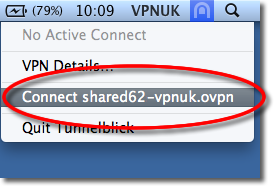
12. Login Details
The first time you connect through Tunnelblick you will be asked for your VPNUK login credentials. If you would like to save the login credentials select the option to ‘Save in Keychain’.
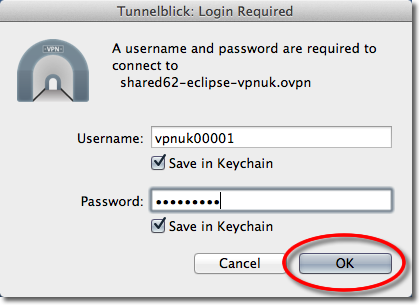
Troubleshooting Guide
Go to Terminal: Finder > Applications > Utilities > Termnial.
To display the full list of available hardware enter the following command: sudo networksetup -listallhardwareports
You now need to disable IPv6 on your network connections and VPNUK account.
The command for disabling IPv6 on your Wi-Fi connection is usually: sudo networksetup -setv6off Wi-Fi
The command for disabling IPv6 on your Ethernet connection is usually: sudo networksetup -setv6off Ethernet
The command for disabling IPv6 on your VPNUK connection is usually: sudo networksetup -setv6off VPNUK
Run all of the necessary commands and then go to your networking overview: Launchpad > Network
Select your Ethernet connection and click onto the Advanced button.
Go to the TCP/IP tab and ensure IPv6 is set to: Off.
Repeat the procedure for your other connections (Wi-Fi and VPNUK).
ISP DNS Hijack / DNS Leak Protection
Some ISPs will attempt to hijack your DNS settings which hinders the VPN connection from functioning correctly. If you find that your VPNUK connection does not route your traffic correctly you can try changing your Public DNS server to the VPNUK DNS server or to an alternative like Google DNS.
1. Right click onto your network connection icon in the menu bar and select Open Network Preferences.
2. Click onto your active internet connection from the left hand menu and then click ‘Advanced’.
3. Go to the DNS tab.
4. Enter a DNS IP into the DNS server box. Google DNS is 8.8.8.8. VPNUK Public DNS is: 109.169.6.2
5. Click ‘OK’ and ‘Apply’ the change.
Optional Settings and Configuration
Connecting to multiple VPNUK servers
You can download as many OpenVPN configuration files as you want. Each one has its own unique name so you’ll know which connection is which.
Automatically starting Tunnelblick upon login
Tunnelblick was designed as a persistent menu icon that survives reboots. To this end, it inserts itself into the login items when it is started and only removes itself from the login items when you choose Quit from the menu or Command-Q from the ‘OpenVPN Log’ window. So if you just log out, shut down, or restart your computer, or it crashes, the next time you log in, Tunnelblick will automatically start. If you do not want Tunnelblick to start automatically, quit Tunnelblick before you log out, shut down, or restart.
Automatically opening a VPN Connection when Tunnelblick starts
You can specify that a connection automatically be opened when Tunnelblick starts by putting a check in the ‘Automatically connect on launch’ checkbox for that connection. The checkbox is located on the connection’s tab in the ‘OpenVPN Log’ window.
Uninstalling Tunnelblick
To uninstall Tunnelblick, move Tunnelblick.app from the Applications folder to the Trash. Other than the preferences and configuration files described in “File Locations”, there are no other files installed — OpenVPN, the tun/tap kernel extensions, and up/down scripts are contained within the Tunnelblick.app package and are loaded only when needed directly from there. Tunnelblick may store passphrases or passwords in the Keychain at the user’s request.
